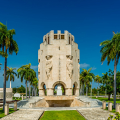SANTA IFIGENIA CEMETERY
It is one of the most beautiful cemeteries of Cuba and it is a visit to make absolutely during your passage in Santiago de Cuba! Inaugurated in 1868, all white and made of Carrara marble, very green and immense, it is organized in masterly alleys where the tombs are often surmounted by superb sculptures.
Although it is a very pleasant place to walk around, in order to fully grasp its history and complexity, we really recommend a guided tour (about 1 hour), just ask for it when you buy your ticket. The Santa Ifigenia cemetery and its 10,000 graves includes the graves of many ordinary inhabitants of Santiago de Cuba but also of some of the great families of the city and especially of illustrious characters of Cuban history, which makes it similar to the Père Lachaise cemetery in Paris and makes it an open-air museum.
José Martí's mausoleum. José Martí, the Apostle of the Homeland, rests in a magnificent and imposing white marble mausoleum on which one can read: "When I die/Without a homeland but without a master/Have on my tomb a bouquet of flowers and a flag." And indeed a bouquet of white flowers and the Cuban flag are in the mausoleum permanently in accordance with his wishes ...
Fidel Castro's tomb. At the entrance to the cemetery lies Fidel Castro who died on November 25, 2016 in Havana. He is buried a few meters from José Martí, for whom he had great admiration and who inspired him throughout his career. After being cremated, his ashes traveled throughout the country during the 9 days of national mourning before being buried here on December 4, 2016 in strict privacy. 21 cannon shots were then fired but no speeches were made according to his last wishes. His grave is very sober, materialized by a block of pure granite 2.5 m high and 42 tons, extracted from the Gran Piedra, which is part of the Sierra Maestra, and which symbolizes the strength of the Cuban Revolution. Fidel's remains are inside this granite block to symbolize Fidel's action inside the Sierra Maestra. A symbolism that refers directly to the quote of José Marti "All the glory of the world is in a grain of corn". The green plants all around symbolize the Sierra Maestra, which had a key importance in the finalization of the Cuban Revolution. All around the granite block and the plants, 19 columns can be seen, representing the 19 warring fronts set up in the Sierra Maestra by Fidel; they are joined by a bronze chain that represents the common struggle of all these fronts for the triumph of the Revolution. On the granite block is simply affixed a marble plaque with the inscription "Fidel". This simplicity is an integral part of Fidel Castro's last wishes, as he did not want any statue or monument in his cemetery, or even anywhere else in the country, as he rejected any personality cult.
Other Cuban personalities in the cemetery. Other heroes of the war for independence and the revolution are also buried there, such as Mariana Grajales, considered the mother of the country by Cubans, as she sacrificed most of her children in the war against Spain for Cuba's independence; Carlos Manuel de Céspedes, considered the father of the Cuban homeland, because this rich landowner was the main initiator of the war of independence against Spain; Frank País and the fighters of the attack on the Moncada barracks as well as those of the uprising of November 30, 1956. Finally, several famous Cuban music artists are buried here, including Compay Segundo, the singer of the Buenavista Social Club. On his grave there is a replica of his hat and guitar, which he never left, and 95 bronze flowers that represent the age of the singer's death. Compay's remains are above the funerary monument, in a beautiful wooden box placed on sand from Siboney, where Compay Segundo was born in the province of Santiago de Cuba.
The tomb of Napoleon Bonaparte's doctor. During your visit to the cemetery, you will notice many French surnames, including the Corsican François Antommarchi, the fourth and last doctor of Napoleon Bonaparte. He was the one who made Napoleon's death mask. He came to Cuba after Napoleon's death and is considered the pioneer of ophthalmology in Cuba, as he was the first doctor to perform a cataract operation in Cuba, which took place in Santiago de Cuba itself. He also founded the first medical center in the city to treat patients suffering from yellow fever, from which he died in 1838.
The changing of the military guard. Throughout the day, every half hour, the military guard is relieved at the entrance of the cemetery. The rest of the time the soldiers are not allowed to move.
This is the only military ceremony of its kind in the whole country. It has been held since 2002, following an idea of Fidel Castro, who wanted to pay homage to José Marti first, before extending this homage to the mother and father of the Cuban homeland, namely Mariana Grajales and Carlos Manuel de Cespedes. Since the death of Fidel Castro in 2016, this military ceremony also pays tribute to Fidel, considered the4th major figure in the Cuban revolutionary process.
Book the Best Activities with Get Your Guide
Members' reviews on SANTA IFIGENIA CEMETERY






